When it comes to offshore jigging, images of anglers ripping up jigs at a million miles an hour using heavy mechanical jerks comes to mind. Much of this perception stems from the southern kingfish and amberjack fisheries, which have used high speed jigged metals and kabura style jigs for some time. However, the term ‘jigging’ is far more complex than just a fast moving piece of metal, and can provide offshore anglers with many different options and techniques to fool the fish.
The biggest misconception when it comes to jigging is that high speed is the only way to go. For some styles of jigging and the use of certain jigs, this is definitely the case – Spanish mackerel prefer an extremely fast moving target. The speed of the jig often triggers the predatory instincts of these fish and switches on the bite. However, high speed is not the only trigger that should be considered while jigging, and slow jigging can be just as much, or even more effective than that of one worked at pace.
Slow jigging or slow-pitch jigging as it is more commonly known, is a fast growing fishing technique for the simple reason that it catches a lot of fish. Originating in Japan, the concept of slow-pitch jigging is one that will appeal to many anglers as it can bring a very unique approach and presentation to fish that have seen plenty of baits and soft plastic lures.
Slow-pitching is not about just slowly working your jig to the top. It is more about using the action and design of the jigging rod, in combination with turns of the reel (otherwise known as pitching) to drive the action of your jig. Pitches can be whole turns of the reel or quarter turns depending on the style and design of your jig. While jig design is important, the design of slow-pitch rods plays an important role in maximising the action of your slowly worked jig. To start with, slow-pitch rods tend to have very sensitive tips with a slow tapered parabolic action. These rods will bend very deeply at the entire length, which is essential, as they need to be extremely springy to get the best action out of the jig.
Essentially, when you pitch by turning the reel, the rod will load quickly even on the shortest of pitches. When you stop the retrieve the spring back of the rod will allow the jig to fall on the horizontal where it will flutter down and create a wicked action. The jig resembles a wounded or dying baitfish fleeing off the bottom before fluttering and darting back and forth to the bottom. Strikes occur mostly on the fall.
While high-speed jigs rely on the angler to impart action, in slow-pitch jigging the rod does the majority of the work. For this reason, slow-pitch rods are rarely stronger than a PE4 rating, as they are not designed to really fight fish but solely to impart action on the jig. In fact, it is recommended not to pump and wind on these rods and rather focus on using your reel to retrieve the fish. While it seems quite technical, slow-pitch jigging really isn’t that difficult, especially if you have the right gear for the job. While ordinary jig rods will provide some assistance to get those jigs to dance, a specialised slow-pitch rod will get you the most out of your jigs.
Jig design is also important when slow-pitch jigging. High-speed jigs tend to be quite slender and tapered allowing for maximum speed through the water. Slow-pitch jigs tend to be much wider and incorporate specific angler cuts from the centre of the jig. This is because the wider the jig, the better the flutter on the fall. Jigs such as the Palms ZetZ Slow Blatt are my favourite for this style of jigging as they have an incredible flutter on the fall and most importantly fall very slowly. Even on the shortest of pitches they have an incredible action, which fish just can’t resist. Shorter skinnier jigs such as the Mariah Trickers are also very effective but are a little thinner, which means they will fall faster.
When it comes to reel choice for slow-pitch jigging, both spin and overhead will work. I prefer an overhead reel as it keeps you in contact with the rod, and you don’t have to worry about flicking over or engaging bail arms. I find it is much easier to regulate the pitch levels as well using an overhead. Kabura jigging, which essentially uses a shaped jighead (often resembling an octopus or squid head) with skirts and plastic ties hanging out the bottom is also an effective jigging method. Originating in Japan this style of jigging incorporates a slow style retrieve. Simply drop to the bottom and then use a slow steady retrieve with a wind or two of the reel before pausing. There is no need to flick or twitch the jig as the skirts and plastic ties flutter around and provide all the attraction required. These jigs are dynamite on all species especially those tasty bottom dwellers like coral trout, snapper as well as pelagic fish as they can be worked right through the water column. I particularly love these jigs for coral trout as you can bank them on the bottom which gets their attention before you slowly work them upwards where they are quickly smashed.
Kabura style jigging is nothing new, and there are plenty of octo style jigs out there and some even incorporate a mix of both slow-pitch jig and Kabura style skirts and ties. Some Kabura jigs such as the Yamashita Tai Kabura jigs allow the angler to interchange weighted heads without having to retie or re-rig. If you are keen to give both techniques a go, but are a little worried about where to try – don’t be. Just go to the same places you would fish with bait or soft plastics and give it a go. Both techniques will work over reef, rubble and even over bait schools. If you are chasing bottom dwelling species then work your jigs close to the bottom. Alternatively, if you are fishing mid-water then work your jigs accordingly. The technique is the same, just remember – the slower the better.
Slow-pitch or slow jigging is a terrific way to fish. Unlike high-speed jigging, you don’t have to bust your guts ripping lures through the water; it’s more about using your brains and fishing gear to do the work. So if you are after a new approach that many fish have yet to see then give it a go.
If you would like to view some informative footage around slow-pitch jigging techniques for both offshore and inshore scenarios check out the Fishing Downunder TV Website.
Reads: 7295
A specialised slow-pitch rod like this NS Black Hole Pioneer Slow-Pitch jigging rod will really enhance and support your slow-pitch technique.
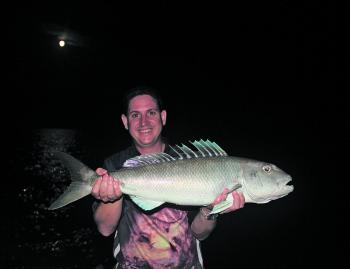
Slow-pitching at night is awesome and a great way to target big predators such as job fish.

Kabura style jigging is a great way to target big GT.
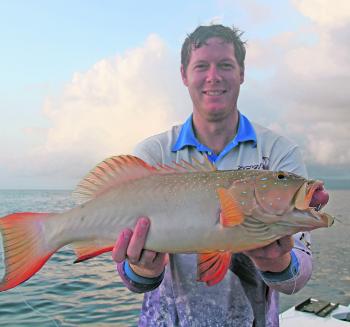
Coral trout are suckers for a slowly worked jig or plastic and this rarely used technique will see great results in hard fished areas.
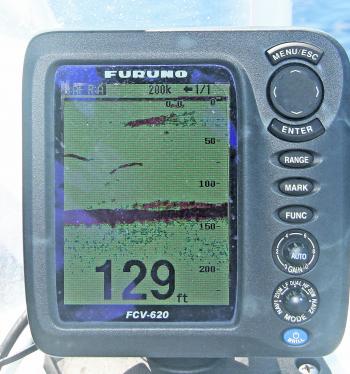
This sounder shot shows a perfect scenario for some slow jigging. Moving onto a reef with some large arches mid way up, perfect for working a jig slowly.

Difficult fish like golden snapper respond well to slow-pitch jigs because this method is rarely fished.
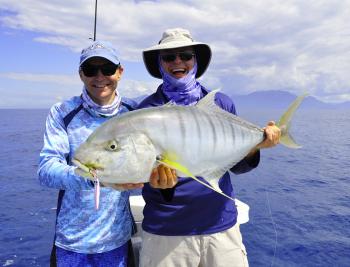
Big goldens love slow fluttering jigs and are great fun to target using this method

A good quality leader is vital to jigging success. FC Rock is soft enough to not take away from the action of the jig but tough enough to withstand heavy punishment from abrasive mouths of fish.
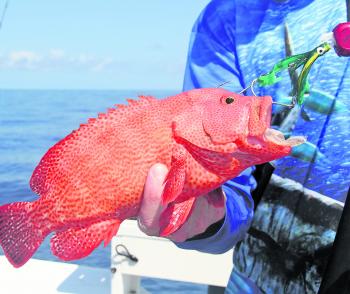
Reef fish love the Kabura jigs, especially the new Yamashita Tai Kaburas with their interchangeable weighted heads.




